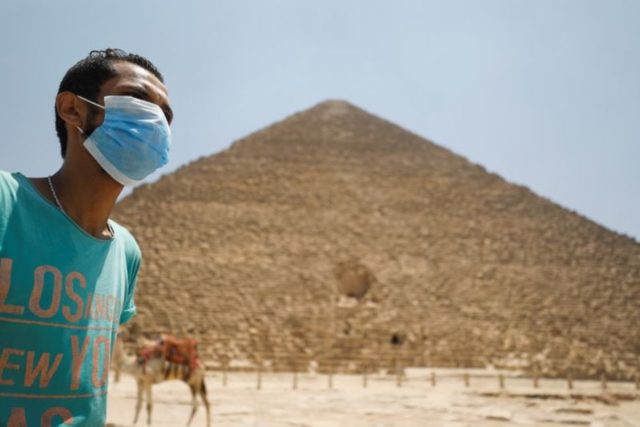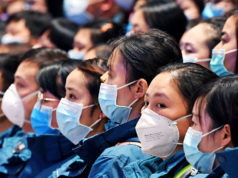
The crisis caused by the coronavirus presents Egypt with a slew of challenges: its large densely packed population; an economy exposed to global shockwaves; and a fragile health system. With the number of infections skyrocketing, the pandemic might exacerbate Egypt’s financial struggles and endanger its political stability. Those most vulnerable to the virus’ economic effects are the millions of day laborers who lack social benefits and are likely to slide rapidly into unemployment and poverty. As such, the benchmark for the Egyptian government in dealing with the crisis is its ability to formulate a plan that balances between the need for social distancing to curb infection and the economic constraints that demand a return to routine as quickly as possible. Despite three months of economic shutdown and social distancing restrictions, Egypt does not appear to be succeeding in its battle against the coronavirus. The number of patients is rising rapidly, surpassing 50,000 infected and 2,000 total fatalities by the end of June.
A major challenge facing Egyptian authorities is the relatively low rate of testing; by the beginning of May only about 105,000 had been tested, at a rate of about 2,000 per day. According to the World Health Organization (WHO), Egypt had a stockpile of about 200,000 tests at the beginning of the crisis but has used half of its total capacity and is reportedly testing a maximum of only 30,000 people a week. Egypt’s younger population works in its favor, with only 4.6 million of its approximately 100 million citizens over the age of 65.
It’s important to highlight the questions regarding the veracity of Egypt’s coronavirus data. The international media has cited estimates that the actual extent of COVID-19 is far higher than reported, while Egypt’s Minister of Higher Education, Khaled Abdel Ghaffar, estimated in early June that the true number may be as high as 117,000 COVID-19 cases. While the official message from Egypt is that the outbreak is still under control, other reports claim that the Egyptian health system is no longer able to cope with the large extra burden and may find itself in danger of total collapse.
Ahmed al-Sobky, who heads the Egyptian General Authority for Health Care, announced in the beginning of May that hospitals had reached maximum capacity, with the Egyptian Medical Syndicate warning of “a catastrophe affecting the entire country” calling for a full lockdown. Even in normal times, hospitals suffer from a lack of intensive care beds and ventilators, and substandard sanitary conditions make it difficult to protect medical staff and patients from the spread of the virus. Currently, Egypt has only 1.2 doctors for every 1,000 people, significantly fewer than the OECD average of 3.4 and the global average of 1.8. The shortage of medical personnel compounds the difficulty of preventing contagion in a population of 100 million people living in overcrowded conditions.
As the battle against the worldwide pandemic contintues doctors and medical staff are protesting the dangerous conditions they are forced to face as a result of an insufficient supply of protective gear. Hundreds of medical staff have already been infected, with dozens of deaths, while doctors have taken to social media to complain of Egypt’s “inaction and negligence to protect them.” Particularly enraging to doctors is the failure to provide treatment facilities to infected medical personnel, and the Health Ministry’s refusal to test medical staff who had been in contact with confirmed cases. While promising to address the issue, Egypt’s Health Ministry disputes the Syndicate’s numbers regarding the medical staff who have been infected.
The Egyptian Ministry of Health has established a situation room to coordinate the response to the outbreak along with a call center to provide citizens with information. Three hundred seventy-six hospitals throughout the country, with over 90,000 beds, have been designated for diagnosing and quarantining coronavirus patients. In addition, 1,000 ambulances have been allocated and medical centers were equipped to receive thousands of cases. Meanwhile, hospital physicians have been afforded better employment terms, with their numbers boosted by retired doctors and medical lecturers and students. In an attempt to keep hospitals from being overwhelmed, the Health Ministry Authorities launched an effort promoting local manufacture of ventilators to add to the existing 5,000. Meanwhile, patients in mild condition are being diverted from hospitals and sent to alternative facilities requisitioned for medical purposes or to their homes.
Partial Social Distancing
Starting in mid-March, Egypt’s strategy to reduce contagion revolved around partial social distancing. Measures implemented included a nighttime curfew, shuttering entertainment centers and restaurants, a ban on smoking hookahs in public areas, the suspension of flights, quarantine of those returning from overseas, closure of schools and universities, a ban on prayers in mosques and churches, restrictions on governmental activity, promotion of working from home, reduced crowding on public transportation, bans on gatherings, and closure of sports and youth clubs. The regulations initially led to a 35-50 percent decrease in traffic in public places, reflecting both the partial response by the public, and the government’s decision to refrain from harsher steps that the Egyptian economy would be unable to withstand.
However, the public’s commitment to the draconian measures appears to be rapidly fading. Reports speak of the public openly flouting the health guidelines, with hundreds of thousands of people remaining outside after curfew during the month of Ramadan. According to Egyptian officials, the disregard for social distancing lies behind the country’s rapid infection rate, pointing to data showing just an 11 percent decrease in frequenting of markets.
Despite the consistent rise in infection rates and fatalities, the Egyptian government gradually began to roll back some of the lockdown restrictions following the Eid al-Fitr festival. In mid-May, the Health Ministry unveiled its plan to return the country to normal in three phases over 90 days. The new measures include permitting hotels to operate at 25% capacity (50% by June) for domestic tourism, along with courts, real estate registries, shortening curfews, and the resumption of flights. The first phase includes heavy restrictions on hotels and other businesses and is slated to continue until the country’s total number of coronavirus cases drops for two consecutive weeks. The second phase would last for 28 days before transitioning into the final stage that would remain in place until the WHO lowers the total risk level from COVID-19.
Observers explain the discrepancy between Egypt’s push to remove restrictions and the negative public health situations as a desire to mitigate the economic fallout. The Health Ministry has spoken of Egypt’s need to “coexist with the coronavirus” and refused to recommend extending the lockdown even as new cases passed its self-declared peak of 500. Yet, the increasing infection numbers have drawn harsh public and governmental criticism on the Health Ministry, with calls to review the original plan.
For the Egyptian government, the pandemic presents a challenge but also an opportunity to demonstrate leadership and control, and to prove the necessity of state authorities as the responsible address during a crisis. Leading the operation is the military, which has embarked on a campaign under the name: “The Egyptian Armed Forces – the Protection and Support,” through which they perform a range of tasks, including: monitoring and maintaining border security, disinfecting roads and public buildings, operating military hospitals, assisting the police in maintaining public order and enforcing social distancing, preparing emergency stocks of food, and producing and supplying protective masks for free distribution to the population. While the Health Ministry and the military stand at the forefront of the battlefield against the pandemic, President Abd al-Fattah el-Sisi appears to be attempting to keep a safe distance from the daily management of the crisis.
Economic Threat
The pandemic has struck at the economic progress achieved by Egypt in recent years, reflected in encouraging growth rates and lower unemployment and inflation. Specifically, the coronavirus has now weakened major pillars of the economy. Millions of Egyptians who work abroad (mostly in the Gulf states) remitted some $29 billion to Egypt in 2019, but many have been fired or had their wages cut and tens of thousands have already returned to their home country; the tourism industry has also been particularly hard hit, having only recently recovered from the turmoil of the last decade. The sector, which saw profits of $12.4 billion, accounted for about 15 percent of GDP, while providing some four million jobs (12.6 percent of the workforce). The aviation industry lost 2.5 billion Egyptian pounds (EGP) in March alone; traffic along the Suez Canal plummeted due to the recession in global trade and the plunge in global oil prices, and forced Egypt to announce large discounts on transit fees. Another point of concern is Egypt’s plummeting foreign currency reserves, which fell from $45 billion in February to $37 billion two months later, with some ratings agencies predicting that it may reach $31 billion by the end of the year.
A major question is the potential impact the economic downturn will have on Egypt’s political stability. On the one hand, recent economic reforms have increased Egypt’s flexibility in responding to the health crisis and stabilized its macroeconomic position. On the other hand, the reforms included the elimination of subsidies and thus increased the poverty rate to 32.5 percent, and intensified the vulnerability of the middle to low socioeconomic class. According to International Food Policy Research Institute estimates, the crisis will cause a reduction in GDP of 0.7-0.8 percent each month, and cut average household income by about 10 percent. The Egyptian Center for Economic Studies estimates that the crisis will cause 12 percent of already-poor people to sink deeper into extreme poverty and increase the overall poverty rate to 44.4 percent. In 2020, according to the International Monetary Fund, growth in Egypt will drop to 2 percent (down from the expected 5.7).
The most vulnerable sector is the 12-14 million irregular day laborers, who lack permanent employment and social benefits. Most of them belong to the middle to lower class, and as their distress mounts, there will be greater potential for social unrest and protests. In order to improve their situation, the government has authorized a special grant of 500 EGP per month for three months, but it will be difficult to bear such a burden beyond that. Charity organizations are also gearing up to provide help for those struggling, while food chains are selling basic necessities at subsidized prices. In a sign of the heavy economic toll caused by the pandemic, the Egyptian Food Bank announced that 15 million families have requested assistance, a 300 percent increase from previous years. The cost of living is expected to rise even more, increasing the burden on working-class Egyptians. In April, the IMF predicted that consumer prices would rise 5.9 percent by next January and 8.2 percent in 2021.
The Egyptian government has allocated 100 billion EGP (about $6.4 billion) to deal with the crisis, and has invested 20 billion EGP to stem the collapse of the stock exchange. Some of these moves are designed to assist businesspeople and companies in the private sector, and include reduction of interest rates and elimination of bank commissions, relief on taxation and debt repayments, a reduction in the price of electricity and gas for industry, and support for hotels. Part of the budget will be funded by postponing the launch of national projects, including the move of government offices to the new administrative capital. In addition, government ministers and members of parliament are being asked to donate part of their salary to the national fund, “Tahya Misr.”
Finally, Egypt appealed to the International Monetary Fund (IMF), which approved a $2.8 billion loan in early May and a one-year $5.2 billion fianancing package in early June to help the country alleviate the economic impact of the pandemic. The Bank of Egypt also continued its policy of quantitative easing, cutting interest rates by 3 percent and selling almost $100 billion in debt.
Conclusion
In Egypt, even more so than in affluent Western nations, economic considerations play a vital role in any plans for a return to routine. The choice is between difficult alternatives: business people are calling for a renewal of economic activity even at the cost of higher morbidity rates in order to avert economic collapse in the form of bankruptcies, mass hunger, and anarchy; medical experts warn that containing the spread of the virus mandates additional economic victims, and perhaps even a complete lockdown for a limited period. At present, although there is no sign that the infection curve is flattening, the government is prioritizing resumption of economic activity under increased enforcement of the required health safety measures.
Ofir Winter, Ph,D., is a research fellow at the Institute for National Security Studies (INSS). Tzvi Lev is an intern at the INSS.





